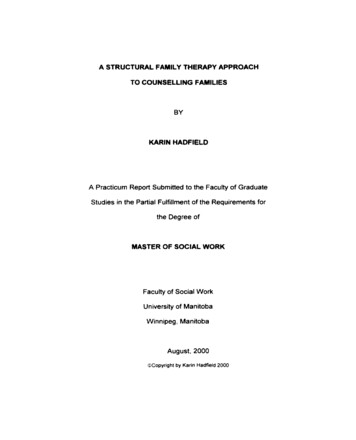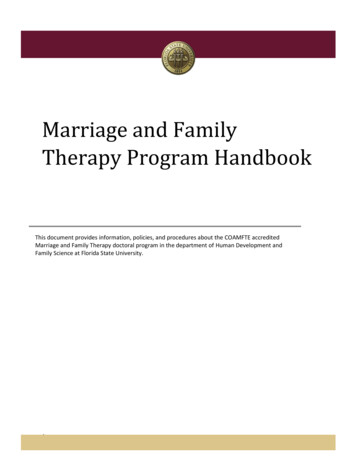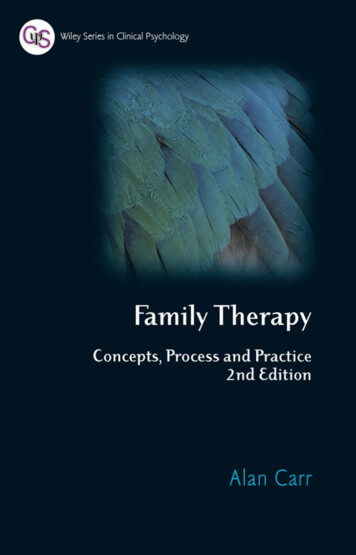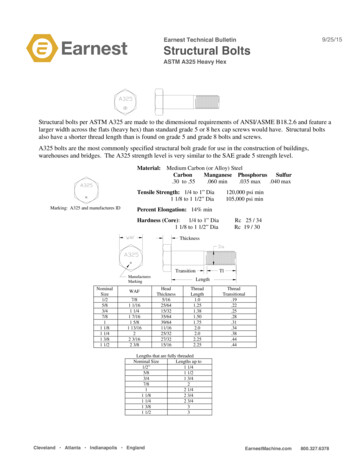
Transcription
A STRUCTURAL FAMILY THERAPY APPROACHTO COUNSELLING FAMILIESA Practicum Report Submitted to the Faculty of GraduateStudies in the Partial Fulfillment of the Requirements forthe Degree ofMASTER OF SOCIAL WORKFaculty of Social WorkUniversity of ManitobaWinnipeg, ManitobaAugust, 2000@Copyrightby Karin Hadfield 2000
I*mNational Libraryof CanadaBibliothèque nationaledu CanadaAcquisitions andBibliographie ServicesAcquisitions etservices bibliographiques395 Wellington StreetOttawa ON K1A ON4Canada395. rue WellingîonOnawaON K l A O N JCanadaThe author has granted a nonexclusive licence allowing theNational Library of Canada toreproduce, loan, distribute or sel1copies of this thesis in microform,paper or electronic formats.L'auteur a accordé une licence nonexclusive permettant à laBibliothèque nationale du Canada dereproduire, prêter, distribuer ouvendre des copies de cette thèse sousla fonne de microfiche/fihn, dereproduction s u .papier ou sur formatélectronique.The author retains ownership of thecopyright in this thesis. Neither thethesis nor substantial extracts fkom itmay be p t e ord otherwisereproduced without the author'spermission.L'auteur conserve la propriété dudroit d'auteur qui protège cette thèse.Ni la thèse ni des extraits substantielsde celle-ci ne doivent être imprimésou autrement reproduits sans sonautorisation.
THE UNIVERSITY OF MANITOBAFACULTY OF GRADUATE STUDIES*****COPYRIGHT PERMISSION PAGEA Structurai Family Therrpy Approach to Counseiling FamiliesA Thesis/Practicum submitted to the Faculty of Graduate Studies of The Universityof Manitoba in partial fulfillment of the reqairemenb of the dtgreeofMaster of Social WorkKAIUN HADFIELD O 2000Permission has been granted to the Libnry of The University of Manitoba to lend or seUcopies of this thesis/practicum, to the National Libnry of Canada to microfilm thisthesidpracticum and to lend or seU copies of the fiLm, and to Dissertations AbstrrctsInternational to publish an abstract of this thesis/practicum.The author reserves other publication rights, and neither this thesis/prrcticum norextensive extracts from it may be printed or otherwise reproduced without the author'swntten permission.
Step-Families . -80Assessrnent . -83Focusing on Strengths . 86CONCLUSION .89REFERENCES .95APPENDIX .100
FIGURESFigure 1Figure 2Figure 3Figure 4A Family Genogram . .44A Family FAM Profiles .5 66 Farnily Genogram . - 5 9B Family FAM Profiles . - 7 2
ivABST RACTFamilies are living systems that grow and change over time. Families must beable to adapt to changes or else the viability of the family and its individualmembers is threatened. Structural family therapy is a therapeutic approach thatrecognizes that families possess many strengths and it attempts to move familiesbeyond dysfunctional patterns of interaction. This practicum report describes theapplication of the structural farnily therapy model to eight families. This analysiswiil consider the processes of assessment, intervention, and evaluation, and aswell, the overall effectiveness of the structural family therapy model.
vACKNOWLEDGMENTS1 would Iike to acknowledge a number of people who contributed to thecompletion of this work. Firstly, I am grateful to the farnilies who made this workpossible and demonstrated to me the strength and resilience of families. I amalso thankful to my advisor, Diane Hiebert-Murphy, for her assistance, supportand constant encouragement. I also appreciate the support of my cornmitteemembers Kathy Levine and Linda Perry.Most importantly, I am appreciative of a wonderful family who supportedand inspired me through this work. I am especially thankful for the help of myolder sister, Jacqueline, who was an invaluable source of aid. 1 am grateful forthe support of my husband who made many sacrifices for this to be completedand was always a source of encouragement and cornfort. As well, I am thankfulfor my daughter, Jordyn, who was very understanding when I had to workinstead of play.
INTRODUCTIONThis practicum involved the application of structural family therapy tofamilies experiencing difficulties functioning. My learning objectives consisted ofthe following: to familiarize rnyself with the structural family therapy model, todeveiop my clinical social work skills and to acquire a solid foundation in familytherapy.This report is divided into four sections. The first section contains a reviewof the literature on structural family therapy, outlining the major precepts andtechniques utilized in this model. This section also provides a review of some ofthe research on the effectiveness of structural family therapy, as well as acritique of this model. The second section describes the practical aspects of mypracticum, including setting, procedures and a general description of the clientswith whom I worked.The third section of this report provides an in-depth case analysis of twoof the families I counseled. In particular, a description of the assessment,intervention and evaluation of each case is provided. The fourth and final sectionincludes a discussion of some of the prevalent themes in my practicum, such asstep-families, remarried families, subsystems and the need to focus onstrengths. I conclude this section by providing an overall analysis of mypracticum and its general results.
SECTION ONE: LITERATURE REVIEWIntroductionThe family unit is one example of a systern that forms a natural socialgrouping. Family members regulate the responses that each member has tointerna1 and external iriputs (Minuchin, 1974). Therefore, from a systemicviewpoint, the family as a whole and the individuals that make up the family aremutually influencing. As such, a change in the family system affects theindividuai just as a change in the individual rnember affects the family as awhole. With these ideas in mind, this report sets out to examine family therapy,and specifically, structural family therapy.To that end, this report will discuss the structural family therapy approachand its basic tenets. The applicability of this model will be addressed in additionto some of its limitations. Although this model was initially developed in the1960s, we wiil see that this approach has evolved and maintains some usefulconcepts that are still of value today. As well, it will become evident that some ofthe shortcomings of structural farnily therapy could be avoided by incorporatingother therapeutic models, such as feminism and a strengths perspective.Overview of Structural Family TherapySalvador Minuchin is the founder of structural family therapy, which hasbeen a leading model in family therapy since its inception. Drawing from thesysternic model, structural family therapy emerged in the 1960s and 1970s as anew model which contained practical ideas that were easily transferable to the
therapy setting (Nichols & Schwartt, 1998). Of great importance were the3constructs that Minuchin fomulated and expanded upon. Today. structural familytherapy is still one of the most widely used models for family therapy (Powell &Dosser, 1992).Structural family therapy focuses upon the person within the familysystem, rather than solely on the individual (Colapinto. 1982; Minuchin, 1974).The major thesis of this approach is that "an individual's syrnptorns are bestunderstood when examined in the context of family interactional patterns"(Gladding, 1998a. p. 210). This idea reflected the shift that occurred in familytherapy during the 1980s which was very different from the prevailing traditionalmental health model which focused upon individual pathologies. Structural familytherapy recognizes that "man is not an isolate" (Minuchin, 1974, p. 2 ) . Therefore,within the family system, each rnember affects the other members. This holdsVue for the larger society as well. People become who they are through theirtransactions with their environment (Minuchin, 1974).Structural famify therapy is an approach that is founded upon the notion ofthe "interrelationship of the wholen (NapolielIo & Sweet, 1992, p. 156). Theindividual, while a separate being, is also a part of the whole family. As welf, theinfluence of each person's behaviour within the family cannot be separated fromother family members' behaviours. The concept of cornplementarityencapsulates this idea that behaviour is circular in the sense that it is sustainedby each member of the family (Minuchin et al., 1998). In other words, anybehaviour is contingent on someone else's behaviour (Colapinto, 1982).
4Colapinto (1991) states that "family members mutually accommodate in such away that one develops selective aspects of himself or herself, while the otherdevelops a complementary trait" (p. 422). For example, a husband whocornplains that his wife never Iistens to him also has a set of behaviours thatreinforces his wife not listening. This concept can be emphasized in therapysessions by asking family members to help each other change and thencongratulating the other members for changing (Nichols 8 Schwartz, 1998). Thisunderscores the interrelatedness of the family.Structural family therapy is also unique in that it focuses on the presentrather than on the past (Colapinto, 1982). The rationale behind this idea is thatpast dysfunctions are manifest in current functioning, hence a change in currentfunctioning could alter embedded dysfunctional behaviour (Minuchin, 1974).Therefore, therapy sessions center around current problems rather than pastconcerns. History is examined only insofar as it affects the present (Aponte,1992).Structural family therapy attributes problems to dysfunctional farnilystructures and the rigidity that results from these structures. A solution is soughtin the modification of the family structure. According to Colapinto (: 982),alteringthat structure requires a change in the position of family members. For example,a family may have a situation in which the father and daughter are extremelyclose and frequently side against the mother. In order to change this pattern, thefather and mother must re-establish the boundary around their parentalsubsystem. Colapinto (1988) describes change as an "increase in the cornplexity
of the structure - an increment in the availability of alternative ways oftransacting" (p.19). Thus, the goal is to make the family more flexible in itspatterns of interacting and responding. Minuchin and Nichols (1993) describe thefamily as being naturally inclined to continue with familiar patterns of interacting.even though developmental changes have made these patterns less functional.The therapist must undermine this homeostasis and move the system towardsbetter functioning (Minuchin 8 Fishman, 1981). Accordingly, change is regardedas being necessary for growth.Powell and Dosser (1992) highlight two important ways in which theassumptions of structural family therapy are different from other family therapyapproaches. These are:(1) families possess the skills to solve their own problems, but for somereason or other do not utilize them. For this reason, a family may require atherapist to help turn its attention to. and assist in maturing. these skills; and(2) family members generally act with good intentions; sometimes it is incarrying out these good intentions that problems may result. As such, there is noblame to be laid and no accusations to be made.Both of these concepts emphasize the focus that structural family therapyplaces on the strengths of the family.Structural family therapy is also influenced by the life cycle model (Nichols& Schwartz, 1998). The family is seen as changing with the different demandsthat are placed on it. McGoldrick (1989) observes that the farnily moves throughdevelopmental stages, each one requiring restructuring. Gladding states that "it
6is crucial not to mistake normal family development and growing pains forpathological patternsn(Gladding, 1998a. p. 214). For example, as a childmatures, his or her parents must adapt their parenting style to accommodatetheir child's growth. The same style will not work for both a three year old and atwenty year old. Problems occur when the family fails to "readjust its structure atone of Iife's turning points" (Nichols & Schwartz, 1998, p. 125). Hence, it is notthe presence of conflict that defines a family in crisis, it is the famity's failure toaccommodate change as required.Minuchin and Fishman (1981) identify four main developmental stagesthat the family progresses through. The first stage is couple fornation. In thisstage a new system is formed and new roles and rules must be established.Families with young children is the second stage. This stage entails developingspecific functions for each spouse to perforrn and a rearrangement of familyrelationships with the birth of a child. The third stage is called families withschool-age or adolescent children and this stage is characterized by a need forthe family to relate to other systems. Families wifh grown children is the finalstage. During this period the farnily re-negotiates its roles and learns to relate toeach other as adults. As well, the parents become a couple again.Nichols and Minuchin (1999) state that structural family therapy is anaggressive intervention because it challenges families. Using this approachrequires a therapist who is willing to "challenge families bluntly enough to pushthem past habit and avoidance but sympathetically enough for them to acceptchallenge" (Nichols & Minuchin, 1999, p. 131). This requires that the therapist
rnove beyond the discussion of problems and focus on clarifying what thingsfamilies want to change. Colapinto (1991) describes the therapist as taking anactive stance in the therapy process, although he or she does Vary the intensityof his or her involvement over the course of therapy. Interestingly, structuralfamily therapy is viewed as more appropriate for a single therapist because thetechniques used are difficult to coordinate with another therapist (Colapinto,1991).Friesen (1995) outlines five goals of structural family therapy. These are:(1) Creating an effective hierarchical structure in the family.(2) Helping parents to complement each other in their roles as parents inorder to be an effective parental subsystem.(3) Aiding the children to become a subsystem of peers.(4) lncreasing the frequency of interactions and nurturance, if the family isdisengaged.(5) The differentiation of family members, if the family is enmeshed.The significance of each of these goals will become apparent throughout thissection.Due to its practical application, structural family therapy has been veryimportant to the field of farnily therapy. For instance, it has introduced themethods of one way mirror and videotaping (Nichols & Schwartz, 1998),techniques that remain widely used today. Aponte (1992) even goes so far as tostate that training a family therapist hinges on live supervision. Furthermore, thisapproach is often used in the training of family therapists (Aponte & VanDeusen,
81981). Accordingly, it is apparent that structural family therapy has changed thefield of family therapy in some substantial ways.Key ConceptsStructural family therapy utilizes many concepts to organize andunderstand the family. Of particular importance are structure, subsystems,boundaries, enmeshment, disengagement, power, alignment and coalition. Eachof these concepts will be explored in the following section.Structure: One of the most important tenets of structural family therapy isthat every family has a structure (Nichols & Schwartz, 1998). This phrase refersto how a family organizes itself (Nichols 8 Schwartz, 1998). Minuchin uses theterni structure to indicate that families have behavioural patterns, which hedescribes as conservative but changeable (Minuchin & Nichols, 1993). A healthyfamily structure is one in which there are clear boundaries around the systemand its subsystems. Changing a dysfunctional structure means that therapy isdirected towards altering the current structure of the family (Minuchin, 1974). Thegoal of therapy is to increase the flexibility of the family structure (Minuchin &Nichols, 1993).Colapinto (1988) found that the family structure is governed by twoprinciples. First, families have a hierarchical structure in which parents havegreater authority than children. Families that are described as functional arebelieved to have a clear hierarchy with "consistent rules about who is in chargeof what" (Nelson & Utesch, 1990, p. 236). Hierarchical boundaries aremaintained by the rules surrounding each family member's rote (Nelson &
9Utesch. 1990). Discerning the hierarchical structure of a family can be done byobserving the family and seeing which of its memben take charge. Colapinto'ssecond principle is that each family has its own distinct nature. Every family isunique and each of its members develop ways of interacting with each other thatare distinctive. This idea refers to the belief of structural family therapists thateach family functions in its own way and that every family possesses the skills tomove beyond dysfunction.Families with either a well-organized structure or a disorganized structurewill still contend with stress and experience various crises. It is significanthowever. that families with a clear and organized structure will recover morequickly and will function better in the long terni than those families that havedysfunctional structures (Gladding. 1998a). Accordingly. while an appropriatefamily structure will not help a family avoid crises. it may help in its recovery fromsuch crises.Subsystems: Minuchin built upon systemic theory by postulating that thefamily system can be further divided into subsystems (Lester, 1997).Subsystems are "smaller units of the system as a whole" (Gladding, 1998a. p.212). and consist of one or more individuals. It is through these subsystems thatfamilies negotiate which members will carry out what functions (Jones, 1980).Relationships between subsystems are governed by spoken and unspoken rules(Minuchin et al., 1998). The broad categories of subsystems that are typical in afamily are the parental subsystem. the spousal subsystem. the parent-childsubsystem and the sibling subsystem. In addition to these common subsystems,
10it should be noted that each family may also create its own particularsubsysterns (Karpel & Strauss, 1983). An example of this could be a family thatorganized the sibling subsystems according to gender instead of age.A family begins when two people join for the purpose of foming a family(Minuchin & Fishman, 1981). These two people f o m a spousal subsystem. Theywill negotiate roles and a structure will develop underlying their transactions(Minuchin & Fishman, 1981).The spousal subsystem works best when thespouses accept their interdependency (Gladding, 1998a). One of the mostimportant tasks for the spouses is to develop a boundary around theirsubsystem. Minuchin and Fishman (1981) state that the developrnent of thisboundary is crucial to the viability of the family structure, as it is from the spousalsubsystem that children learn about intimate relationships. Any dysfunction inthis subsystem will be evident in the family system (Minuchin & Fishman, 1981).As the couple has children, the couple forms a parental subsystem. Insome families, the parental subsystem may consist of extended family or singleparents. Again, for a child, this is the basis for how she or he views authority andrelates to people who have greater strength and power (Minuchin, 1981).Children learn whether their needs will be met in their family and develop asense of who they are from their parental subsystem. As the child grows, theparental subsystem must change and grow as well (Minuchin, 1981). While theadults in this subsystem have the responsibility of providing for the needs of theirchild(ren), they also have rights (Minuchin, 1981). For instance, parents maychoose what school their child will go to and can detemine rules that provide for
11the safety of each family member. As Karpel and Strauss (1983) point out, adistinction needs to be made between the spousal and parental subsystemsbecause each role demands something different and is considered essential tothe family systern.The sibling subsystem is also important. This unit contains familymembers who are of the same generation. This subsystem also forms the child'sfirst peer group (Minuchin, 1981). It is within this subsystem that children learnhow to get along, how to negotiate and how to deal with conflict. These lessonswill impact a child's functioning in school and with his or her peers. In largefamilies. siblings rnay organize themselves into subsystems according todevelopmental stages (Minuchin, 1981; Minuchin et al., 1998). It is importanthowever, that the parental subsystem allow the sibling subsystern to functionwithout too much interference.Boundaries: As pertaining to subsystems, Minuchin suggests thatboundaries are the rules which define "who participates and how much" (1974, p.53). Gladding (1W8a) states that boundaries are "the physical and psychologicalfactors that separate people from one another and organize them" (p. 213).Therefore, boundaries are the invisible barriers that govern the contact thatsubsystems have with other subsystems and are necessary for a healthy familystructure (Minuchin & Fishman. 1981). Some boundaries may be more concrete(Karpel & Strauss, 1983). For instance, a door with a lock on it that closes off theparents' bedroom is one example of a boundary between a couple and siblingsubsystem. Accordingly, boundaries allow the subsystern to perforrn its functions
12without interference from other subsystems (Minuchin, 1 974). In order tofunction well, boundaries must be clear and not too rigid (Minuchin, 1974). Foreach of the family subsystems described above. there needs to be clearboundaries around the subsystern to allow the flow of energy to and from thesubsystem.Families can have boundaries that Vary in their rigidity according to theparticular farnily (Minuchin et al., 1998).For example, one family rnay expect itschildren to eat quietly at the table. Another family may allow its children to benoisy and participate in the dinner conversation. The importance of boundaries isthat they must go through developmentally appropriate changes as the familyprogresses through the family life cycle (Minuchin et al., 1998).Thus. a fathermay intervene when his two young children are fighting. but he would expectthem to work out their differences when they became adults.Boundaries also exist around the family system as a whole. A family isexpected to have a boundary around it that separates it from other systerns(Karpel & Strauss, 1983). For example physically. many nuclear families live insingle-dwelling homes. Another important boundary is the one that separates thenuclear family from the extended family (Karpel 8 Strauss, 1983).It is importantto stress the uniqueness of each family here. and recognize that each family mayhave its own variations of appropriate boundaries.The ideal boundaries are ones that are clear. These boundaries consist ofrules and habits that allow family members to develop better relationships byencouraging dialogue (Gladding. l998a).Family members are able to ''freely
13exchange information and give and receive corrective feedbackn (Gladding,1W8a, p. 213). Clear boundaries allow family members to feel connected to thefamily system, while still maintaining their individuality and autonomy (Karpel &Strauss, 1983).Sometimes families do not have clear boundaries, but arecharacterized by boundaries that are too rigid or too diffuse. This is discussedbelow.Enmeshment: Families with boundaries that are diffuse are described asenmeshed. This is a state in which the boundaries are too permeable and thusthere becomes a sacrificing of autonomy in order to maintain the greater senseof belonging to the family system (Minuchin. 1974). Dependence is encouragedand family members tend to stay close to home, expecting to have al1 of theirneeds met by the family (Gladding, 1998a). These members are hesitant to formclose relationships outside of the family (Karpel & Strauss, 1983). This systemlacks the necessary resources to change under stressful conditions (Minuchin,1974). An example of an enmeshed family is one that has no doors on the roomsin their home. This would not allow the family members the privacy they needand would make it difficult to distinguish where the family ended and theindividual began.Nichols and Minuchin (1999) find that one symptorn of enmeshment iswhen farnilies come to therapy with relatively minor cornplaints about thechildren. This could include a family that comes to therapy because one child istalking back and not participating in household activities. While sorne familiesmight see this as typical behaviour, an enmeshed family would feel that this
14"individuality" is threatening to the family system.Disengagement: Disengagement occurs when families have boundariesthat are overly rigid (Minuchin, 1974). Inflexible boundaries serve to keep peopleseparated from each other. Members have significant independence but Iittteinterdependence exists within the family system and there is little communicationbetween the subsystems (Minuchin, 1974). As a result, family members havedificulty relating to each other in an intimate way and become disconnected fromother family members (Gladding, i998a). To illustrate this concept, one couldthink of a family in which the members are unaware of the important events inthe other member's lives. Karpel and Strauss (1983) state that the therapist maybe amazed at the way in which a disengaged farnily can tolerate deviance orpain without concern or interference.Power: The concept of power refers to the level of influence that eachfamily member has on the outcome of an activity (Aponte & VanDeusen, 1981).It is the ability to get something done. Power can Vary according to the setting(for example, a parent's power is different at home than at school) and it isgenerated by the way in which family members react (for example, a father'spower may depend on the response from his wife and children, either reinforcingor negating his power) (Aponte 8 VanDeusen, 1981).Power is also related to structure, in that there is a hierarchy of powerevident in the family structure (Minuchin et al., 1998). This hierarchy defines whomakes the decisions in the family and also who controls the behaviours of familymembers. As with other aspects of family functioning, power is subject to change
15as farnily members grow and develop (Minuchin et al., 1998). For exarnple,children are normally given more power at sixteen years of age than at threeyears of age.Alignment: An alignment refers to the way in which "farnily members asindividuals and as parts of subsystems relate to each other relative to otherfamily members and subsystemsn(Nelson & Utesch, 1990, p. 237).Alignmentscan include both joining or opposing one member or subsystern over another(Aponte 8 VanDeusen, 1981). Within the family system there may exist differentpatterns of joining or opposition. For instance, a mother may disagree with herhusband's method of disciplining their children and consequently rnay side withthe children. While an alignment can include the joining of two people for acomrnon interest (frequently called an alliance) it can aiso include the joining oftwo people actively excluding a third person (called a coalition).Coalition: A coalition is an alignment between two people in a systemwhich excludes a third person. There is a rigid boundary around the coalition.Coalitions are frequently short-lived and may be quite benign (Minuchin et al.,1998). Children deciding to join together to demand pizza for supper instead ofchicken, is one example of a coalition. Coalitions that are stable however,sometimes can be more harmful. An example is a coalition that involves amother and daughter who frequently side against a brother, resulting in a verydistant relationship with him.Of particular importance is a cross-generational coalition. This is definedas an "inappropriate family alliance that contains members of two different
16generations" (Gladding, 1998a, p. 473). This could include parents who arguethrough a child or grandparents who argue through their grandchild. Colapinto(1991) indicates that chronic cross-generational coalitions are structurallyassociated with psychosomatic illness and addiction.Nelson and Utesch (1990) find that coalitions are typically overt and canbe identified by direct obsewation. One way to identify a coalition is when h opeople are talking about a third person in his or her presence (Nelson & Utesch,1990). Coalitions can also be formed when the therapist joins to form a coalitionagainst one or more family members (Minuchin & Fishman, 1987). One result ofthis type of coalition is the stress placed on the family members who are on theinside or outside of this coalition. Care must be taken to ensure that there are norepercussions outside of the therapy session for the person with whom thetherapist was in a coali
pathological patternsn (Gladding, 1998a. p. 214). For example, as a child matures, his or her parents must adapt their parenting style to accommodate their child's growth. The same style will not work for both a three year old and a twenty year old. Problems











